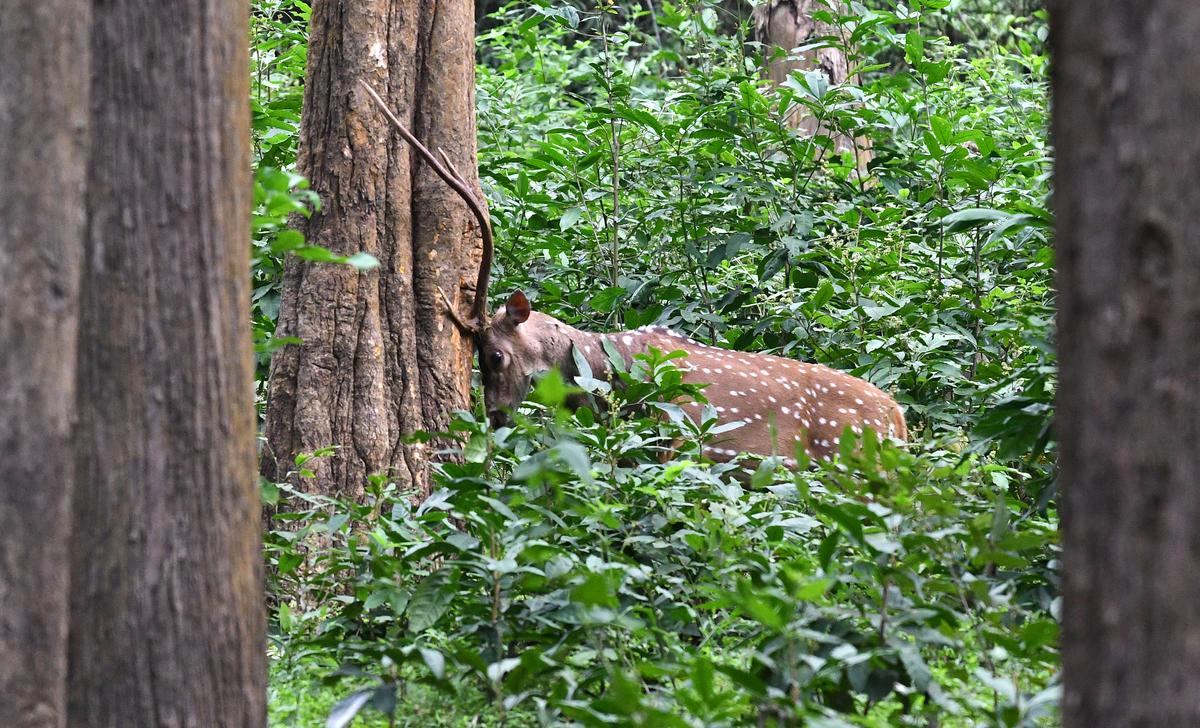One of the scenic roads in Pollachi
| Photo Credit: PERIASAMY M
The tree-lined Anamalai — Sethumadai Road near Pollachi, 45 kilometres from Coimbatore, is a postcard straight out of a dream. It’s not a single tree, but a boulevard of neem and tamarind trees that make up a tunnel-like canopy along the winding road. The rows of spectacular, ancient trees leading to tourist spots like the Anamalai Tiger Reserve, Parambikulam Wildlife Sanctuary, Top Slip, and surrounding villages often stir a happy emotion in weary travellers and tourists alike. As sunlight seeps through towering trees, it takes on pretty patterns along the road even as mynahs and magpies give out loud calls from the trees inviting every traveller to stop and soak up the sights, and sounds of the rural landscape.
The tree-cover on Anamalai – Sethumadai Road near Pollachi
| Photo Credit:
PERIASAMY M
Recently, as many as 20 tamarind trees from this stretch have been saved from going under the axe following protests from NGOs and activists, and an order from the district administration that said no to cutting of trees. “It’s a scenic stretch lined up with trees as old as 50 or 70 years all taken care by the people there. They have fond memories associated with the trees,” says district collector Kranthi Kumar Pati IAS who set the precedent by refusing to grant permission to cut 27 trees along the 16- kilometre stretch from Ambarampalayam to Sethumadai. “We have the District Green Committee that evaluates if trees come in the way of development projects. In some cases when the trees have to be cut, it is transplanted thereby giving a new lease of life.”

A male spotted deer at Topslip of Anamalai Tiger Reserve near Pollachi
| Photo Credit:
PERIASAMY M
These tall trees in Pollachi not only offer a scenic gateway to tourist spots but stand tall as guardians of a thriving bio-diveristy. “Why should trees be the first causality?” asks Pravin Shanmughanandan, founder of Pollachi Papyrus, a travel portal that curates travel experiences in the region.

“Trees are connected with livelihood of people, reptiles, birds, snakes, spiders, squirrels and lizards,” says Syed Kattuva, an eco-warrior and tree crusader. “Trees offer shelter from rain and sun for the passers-by, and you can often find petty shops like nungu and tender coconut sellers, kambu koozh stalls thriving there,” says Syed who is also founder of Green Care, an NGO for conservation. “We have streamlined and put systems in place to save the trees from going under the axe for development works. Officials are receptive when we offer alternate solutions.”
He gives an example to drive home the point. “During a junction improvement work at Iruttupallam long the Perur-Madhamptty-Sadivayal Road leading to Siruvani, we saved a 50-year-old peepul tree with an innovative approach. We retained the tree as a central median. Now, vehicles are plying around the median, accidents have come down, and the tree is standing witness to it all,” explains Syed.

A good diversity of trees along road-sides are also crucial habitats for several forms of wildlife. “They hold urban biodiversity. Many birds use these trees as their nesting ground. For palm jaggery and padhaneer sellers, its their workspace,” says Pravin adding that they have also petitioned the government to conserve the significant tree-lined roads of Pollachi.
Palakkad-Pollachi Road
| Photo Credit:
MUSTAFAH KK
The Anamalai Road stands as a part of Pollachi’s identity and we cannot disturb it says Catherine Saranya, Pollachi Sub-Collector. “The tree cover also contributes and helps improve water table of Aliyar and Sholayur dams in Pollachi,” she says adding that she stood awe-struck and clicked photos when she got posted here.
People’s movements are gaining momentum, says award-winning environmentalist M Yoganathan. “We have to nurture existing greenery on a war footing for the benefit of our future generations. We are already reeling under the El Nino effect that is showing in the form of erratic weather conditions,” he cautions.

Greening Coimbatore is an ongoing process, points out the district collector. The Green Tamil Nadu Mission has set a target to plant 12,58,000 trees in the year 2023-24 where the forest department is entrusted with growing saplings in nurseries and distributing them to the other government departments and the public. The planted seedlings are georeferenced for effective monitoring.
Adds Syed, “We have to do out bit. Nature takes care of the rest. Birds as seed dispersers can literally raise entire forests.”